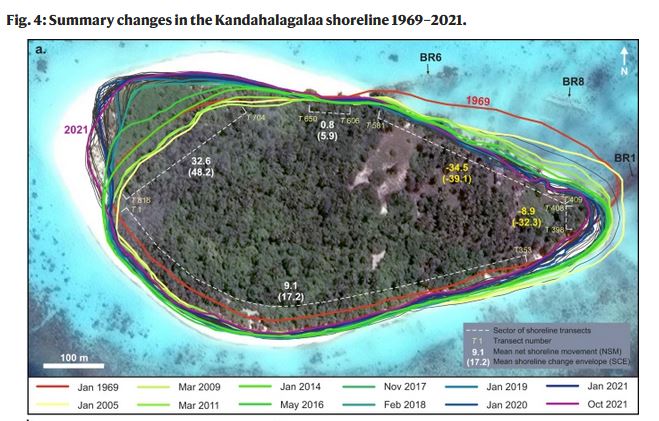A new paper shows islands are young, dynamic creatures, and mother nature is mean. And nothing we see today on Indian or Pacific Islands is unprecedented. All the panic about islands disappearing is nothing compared to what nature does all the time. Indeed, man-made climate change, if it has done anything at all — has been a boon for islands in the last fifty years.
Thanks to Kenneth Richard, at NoTricksZone for finding the paper: Recent Shoreline Changes To 1100 Pacific Islands ‘Dwarfed’ By Change Magnitudes Of The Past
The new paper by Kench et al looked at 1,100 islands across the Pacific and Indian oceans, and even though CO2 levels rose from 325ppm to an apocalyptic 420ppm, the average island got bigger instead of smaller, and only 3 small uninhabited islands completely disappeared. And when we say small, some of the islands we are tracking are mere 30m wide sand spits. Is it really fair to call that an “uninhabited island”?
The world may have Olympic-sized junkets every year because shorelines have moved 40m in the last fifty years, but it turns out that shorelines moved 200 meters before anyone built a coal plant.
This, below, is just the last fifty years in the life of Kandahalagalaa Island, and about 20% of the island has shifted.
Currently sea levels are rising 3mm a year, but in its short life sea levels at Kandahalagalaa have already gone down and up some 900mm without humans doing a damn thing.
Satellite data is all very well for the last fifty years, but it can’t tell us whether islands used to move so much before humans invented the Ford Model T. So Kench and co. got very serious about one little island in the Maldives with the tongue-twisty name Kandahalagalaa. They drilled the holy smoke out of it, and radiocarbon dated the layers until they pieced together its history. They discovered that its whole life has been in a state of flux. It only emerged out of the ocean a during the dark ages, 1,400 years ago, shifted and grew to the south, and the ocean has turned a lot of the island upside down.
The Kench team are data nerds and did some serious drilling — taking some 154 sediment samples from 20 cores, they used 23 samples of a particular green algae to do radiometric age tests. They also did laser levels six different ways to survey the island. They took 11 other cores of outcrops, and used four different satellites to get lots of photos of the shoreline.
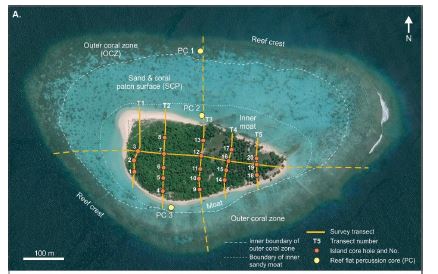
Supplementary Figure 2: The drill holes
This is one churned island
Most of the cores were upside down, with the older layers at the top. Nature is evidently reworking the island, dropping 1100 year old deposits on top of 300 year old ones, in various combinations that were different in nearly every hole.
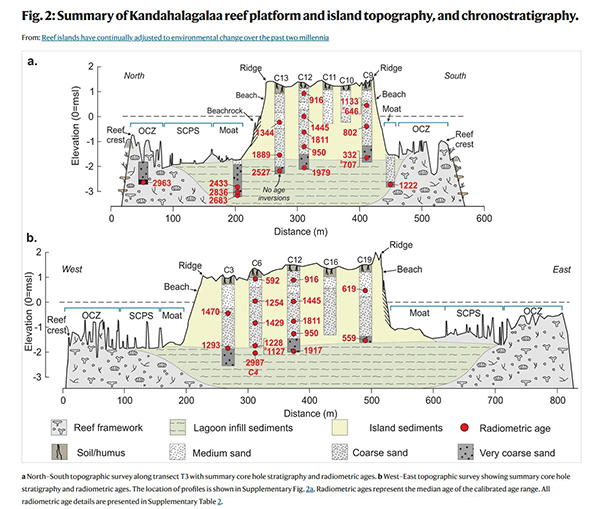
They drilled lots of holes and found the islands age history was a jumble of old layers on younger layers (ages in red) | Click to enlarge.
1,100 Islands of the Pacific and Indian Oceans are stable
Despite the threat of man made climate change, nearly every island larger than a tenth of a square kilometer is the same size as it was or expanding. This is an update on a previous survey of 700 islands which showed they were mostly growing. It’s not necessarily an improvement — Kench et al appear to have just added 400 teeny tiny islands to spread the splatter on the left hand side.
Notice how the log scale gives tiny islands a big role? An island 0.01 km2 is a mere 100m by 100m across. Half the graph is really plotting the fate of shifting sand dunes.
Is it fair to call them islands?
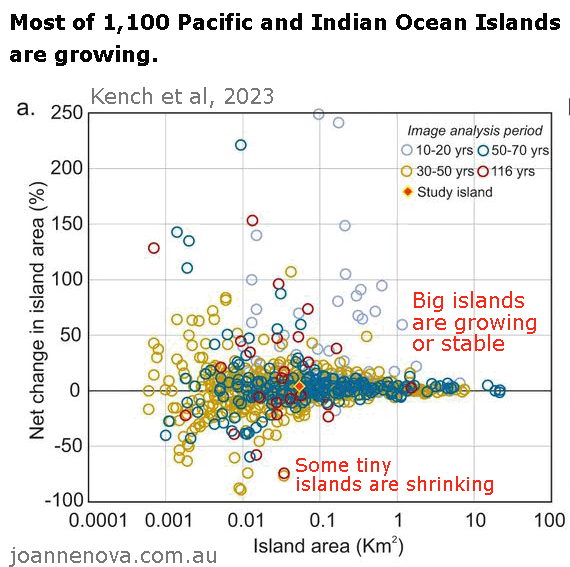
a Data source Kench et al Ref 37
The climate signal got blurred
The authors comment that they were unable to implicate climate change:
Collectively, these studies have been unable to establish specific environmental drivers of island change, nor directly and unambiguously implicate climatic change as a mechanism for observed changes. To date, local-scale processes appear to have blurred any climatic change signal22,24.
Translated: even though everyone says climate change is real and obvious expert researchers couldn’t find a signal above the noise. I suspect Kench et al were disappointed not to find that signal, given he was not happy some skeptics used his study a few years ago. But full credit to the team for being so dedicated at collecting data and writing it up so honestly.
Islands were forming as the holocene sea levels fell
Giving some idea of just how young these islands are, Kench et al reviewed about 15 different studies of islands between the Maldives and Fiji and found that the oldest known samples from each was about 1,500 to 7,000 years old (black circles below). Holocene sea levels (marked in blue) were an unthinkable 2 meters higher 5,000 years ago. Sea levels have been falling around Australia for thousands of years.
The little very-drilled island of Kandahalagalaa is “e” below, with the oldest samples from nearly 3,000 years ago, presumably underwater then, since that was long before Kench declares it it to have emerged from the sea.
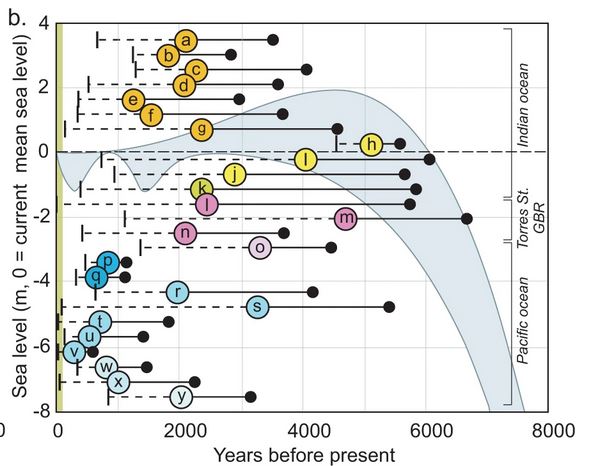
b Summary of reef island evolution studies highlighting the onset and period of island accumulation in the mid-to-late Holocene. Blue-shaded area defines the envelope of sea-level behaviour in the Indo-Pacific. The solid black circle denotes the earliest radiometric age, the coloured circle denotes the mean radiometric age of samples, vertical line denotes the latest radiometric age. Different coloured circles reflect islands in different reef provinces and the letter inside the circle denotes specific islands, a = Mainadhoo, b = Boduhini, c = Galamadhoo, d = Baavanadhoo, e = Kandahalagalaa, f = Kondey, g = Vaadhoo, h = Dhakandhoo, i = Hulhudhoo, j = Thiladhoo, k = Cocos (keeling) Isld., l = Warraber, m = Bewick, n = Lady Elliot Isld., o = Mba, p = Tepuka, q = Tutaga, r = Laura, s = Jabat, t = Jeh, u = Jabnodren, v = Jin, w = Malamala, x = Navini, y = Makin. Source references of data are listed in Supplementary Table 1.
h/t Kenneth Richards, El Gordo, Another Ian.
REFERENCES
Kench, P.S., Liang, C., Ford, M.R. et al. (2023) Reef islands have continually adjusted to environmental change over the past two millennia. Nat Commun 14, 508 doi.org/10.1038/s41467-023-36171-2
